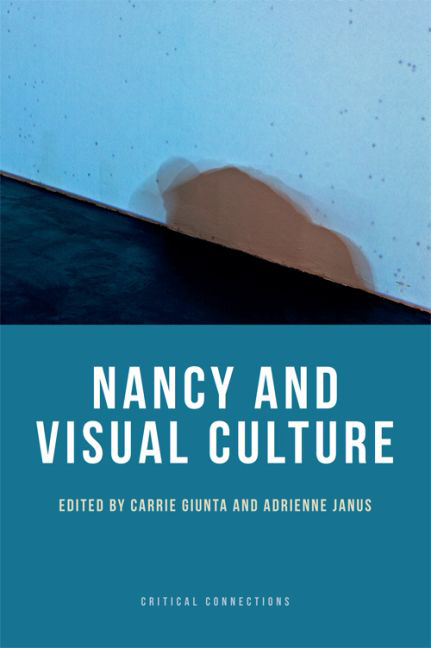Book contents
- Frontmatter
- Contents
- List of illustrations
- Acknowledgements
- Introduction: Jean-Luc Nancy and the Image of Visual Culture
- 1 Cutting and Letting-Be
- 2 Dancing Equality: Image, Imitation and Participation
- 3 A Question of Listening: Nancean Resonance, Return and Relation in Charlie Chaplin
- 4 The Image: Mimesis and Methexis
- 5 On the Threshold: Visual Culture, Invisible Nature
- 6 Pornosophy: Jean-Luc Nancy and the Pornographic Image
- 7 Presentation and Disappearance: Dialogue between Soun-Gui Kim and Jean-Luc Nancy
- 8 Writing in the Place of the Animal
- 9 Together at the Limit: Jean-Luc Nancy, Art and Community
- 10 Turning Around the Written Mark, Opening from a Weight of Thought
- 11 Uncanny Landscapes of Photography: The Partage of Double-Exposure after Jean-Luc Nancy
- Contributors
- Bibliography
- Index
2 - Dancing Equality: Image, Imitation and Participation
Published online by Cambridge University Press: 15 September 2017
- Frontmatter
- Contents
- List of illustrations
- Acknowledgements
- Introduction: Jean-Luc Nancy and the Image of Visual Culture
- 1 Cutting and Letting-Be
- 2 Dancing Equality: Image, Imitation and Participation
- 3 A Question of Listening: Nancean Resonance, Return and Relation in Charlie Chaplin
- 4 The Image: Mimesis and Methexis
- 5 On the Threshold: Visual Culture, Invisible Nature
- 6 Pornosophy: Jean-Luc Nancy and the Pornographic Image
- 7 Presentation and Disappearance: Dialogue between Soun-Gui Kim and Jean-Luc Nancy
- 8 Writing in the Place of the Animal
- 9 Together at the Limit: Jean-Luc Nancy, Art and Community
- 10 Turning Around the Written Mark, Opening from a Weight of Thought
- 11 Uncanny Landscapes of Photography: The Partage of Double-Exposure after Jean-Luc Nancy
- Contributors
- Bibliography
- Index
Summary
This chapter wagers that dance holds a singular, irreducible place in Nancy's work, that it cannot be reduced to thought about dance, and that it provides a way to understanding Nancy's approach to visual culture in general, to equality, and to the circulation of sense in terms of what he calls singular plural being. The chapter takes its starting point from Nancy's discussions of dance in the as yet untranslated Allitérations, a series of email exchanges from 2003 and 2004 followed by transcriptions of face-to-face exchanges between Nancy and choreographer Mathilde Monnier loosely addressing the question of the relation between philosophy and dance, and a conversation between Nancy, Monnier and film-maker Claire Denis. In the first half of the book Nancy raises two questions, each presenting a pair of seemingly irreconcilable demands: 1. How can we understand dance as something open to everyone while retaining the privilege of professional expertise? 2. How can we understand dance in a way that maintains its uniqueness, not reducing it to an example of thought or a vehicle for thought, and yet still allowing for a relation between dance and thought? Both questions invite us to think the privilege of dance together with its openness; its singularity together with its plurality. As Nancy and Monnier grapple with these seemingly contradictory demands in Allitérations, their conversation opens up onto a fresh way to think political equality, and a different way to understand – or ‘catch’, a much more suitable term that I shall introduce later in this chapter – the sense of the world. It is by taking a detour via ‘The Image: Mimesis and Methexis’ that we can also see how Nancy's approach to dance can open to a new way of engaging with visual culture in general.
The point in this chapter is not simply to use dance as an example or illustration that helps us better to understand Nancy's approach to visual culture or the Nancean singular plural or his notion of ‘sense’, for in considering dance in terms of art, singular plurality and sense, we shall also be drawn to reassess sense, art and the singular plural in terms of dance.
- Type
- Chapter
- Information
- Nancy and Visual Culture , pp. 39 - 54Publisher: Edinburgh University PressPrint publication year: 2016



